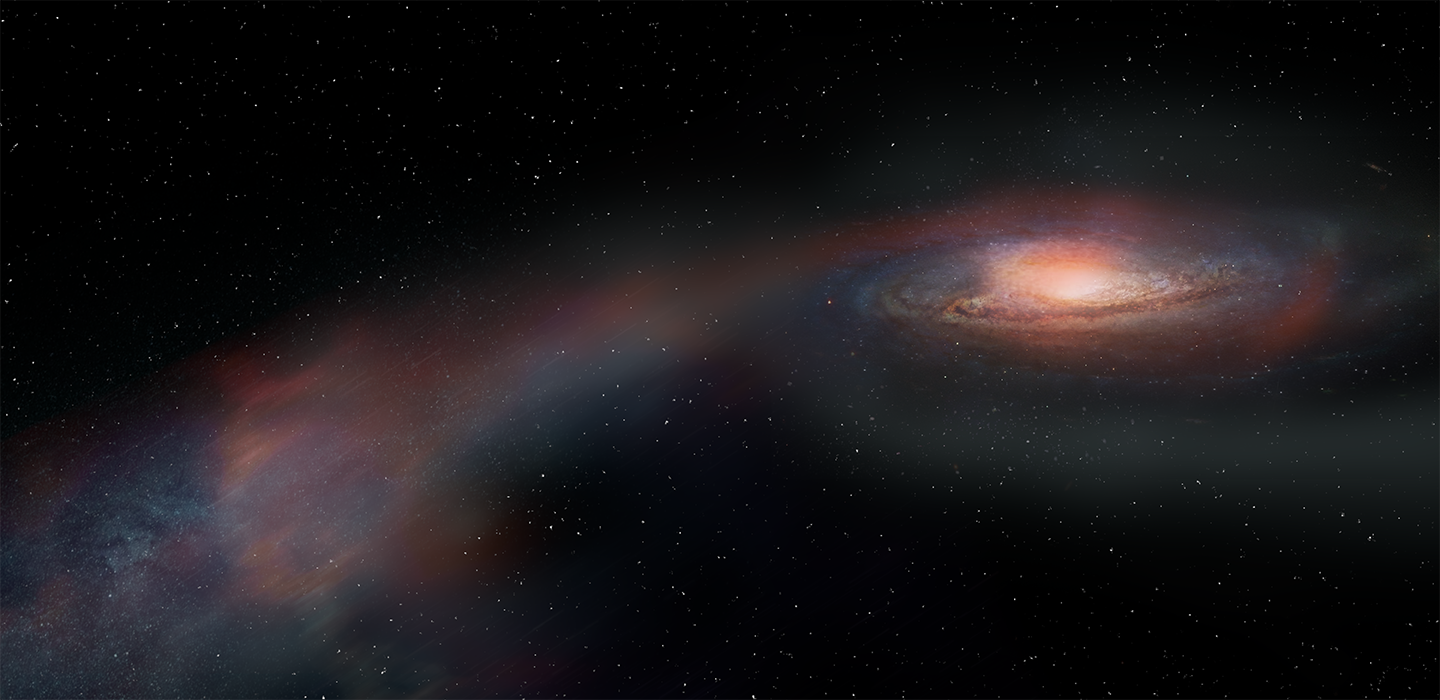
Subscribe to 51ľ«Ć·ĘÓƵwire Today
Get the most interesting and important stories from the 51ľ«Ć·ĘÓƵ.Six billion years ago, two galaxies were colliding, their combined forces hurling a stream of gas hundreds of thousands of light years away. Reported this week by a team including 51ľ«Ć·ĘÓƵ astronomers, that unusual feature provides a new possible explanation for why galaxies stop forming stars.
“One of the biggest questions in astronomy is why the biggest galaxies are dead,” said , a sixth-year physics and astronomy PhD student in the Kenneth P. Dietrich School of Arts and Sciences. “What we saw is that if you take two galaxies and smash them together, that can actually rip gas out of the galaxy itself.”
In the part of space we inhabit, most large galaxies have long ago stopped making new stars. Only recently have astronomers started looking farther away — and thus farther back in time — with the tools to find recently dead galaxies and figure out how they got that way.
The cold gas that coalesces to form stars might escape from galaxies by several means, blown away by black holes or supernovae. And there’s an even simpler possibility, that galaxies simply quiet down when they’ve used up all the raw materials for creating stars.
Looking for examples of galaxies that recently shut off star formation, the team of researchers used the Sloan Digital Sky Survey, which has catalogued millions of galaxies with a telescope at Apache Point Observatory in New Mexico. Along with observations from the ground-based radio astronomy network ALMA, the researchers found just such a “post-starburst” galaxy seven billion light years away that still showed signs of available star-forming fuel. “So then we needed an explanation,” said Setton. “If it has gas, why is it not forming stars?”
[51ľ«Ć·ĘÓƵ astronomers were among the first to use the latest and greatest NASA telescope]
A second pass with the Hubble Space Telescope then revealed the distinctive “tail” of gas extending from the galaxy. From that feature, like forensic examiners working through a telescope, the researchers were able to reconstruct the galaxies’ collision and the tremendous gravitational force that tore apart stars and flung a stream of gas a distance more than two Milky Ways laid end to end.
“That was the smoking gun,” said Setton. “We were all so struck by it. You just don’t see this much gas this far away from the galaxy.”
The team, including 51ľ«Ć·ĘÓƵ Physics and Astronomy Associate Professor and alum Margaret Verrico (A&S ’21) along with colleagues at Texas A&M University and several other institutions, reported their results in the on Aug. 30.
Such an extreme meeting of galaxies is likely rare, Setton said, but because gravity pulls large objects into dense groups, such an event is more common than you might anticipate. “There are all these big voids in space, but all of the biggest galaxies live in the spaces where all of the other big galaxies live,” he said. “You expect to see these sorts of big collisions once every 10 billion years or so for a system this massive.”
Setton’s role on the project was to determine the galaxy’s size and shape, and he discovered that other than the tail, the post-merger galaxy looked surprisingly normal. Once the tail fades in a few hundred million years, it may look just like any other dead galaxy — further suggesting that the process could be more common than it appears, something the team is following up now with another survey.
Along with providing clues for how the universe became the way it is, Setton said such collisions reflect one possibility for the future of our own galaxy.
“If you go to a dark place and look up at the night sky, you can see the Andromeda Galaxy, which in five billion years might do exactly this to our Milky Way,” Setton said. “It’s helping answer the fundamental question of what’s going to happen to the Milky Way in the future.”
Ěý
Illustration courtesy of ALMA (ESO/NAOJ/NRAO), S. Dagnello (NRAO/AUI/NSF)


